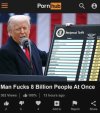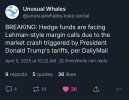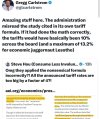Shocker. Apparently we’re all being deliberately obtuse, right
@2010sarenevercomingback?
https://www.axios.com/2025/04/06/trump-tariffs-error-aei
Trump tariffs based on massive error, conservative think tank says
The
formula used by the Trump administration to levy reciprocal tariffs contains a serious math error that over-inflates the impact by about a factor of four, economists at the American Enterprise Institute said.
Why it matters: The conservative think tank says the error led to tariff rates massively higher than they should have been to achieve the goals the administration sought.
Catch up quick: After announcing the tariffs last Wednesday the Trump administration released a
complicated-looking formula, which it said was developed with the Council of Economic Advisers, used to determine how to set the rates.
- It turns out the formula is simply the U.S. trade deficit with each country, divided by the value of the goods the U.S. imports from that country.
- Two other variables in the equation cancel each other out, rendering them effectively meaningless.
Yes, but: AEI's economists Kevin Corinth and Stan Veuger
say they shouldn't cancel each other out, because Trump's team used the wrong level for one of them.
How it works: One of the variables relates to the "elasticity of import prices with respect to tariffs," which is to say, how much import prices move as tariffs are applied.
- The administration's calculation assigns a value of 0.25 to that variable, which in the math of price elasticity suggests most of the tariff impact does not hit the import price of an item as it enters the country.
- But the AEI paper says they used the wrong value for import prices, and instead used the value for a retail price, or what happens to the final consumer price after the good is imported and distributed.
- They argue, instead, that the right value is 0.945 — in other words, almost all of the tariff hits the import price of a good as it's brought into the country.
- "It is inconsistent to multiply the elasticity of import demand with respect to import prices by the elasticity of retail prices with respect to tariffs," the authors write.
For example: Corinth and Veuger write that if the tariffs had been calculated correctly, with the same ultimate goals in mind but using the right kind of elasticity figure, the levy on a country like Vietnam would have been 12.2% and not 46%.
The intrigue: In making the case for their approach, including their formula, the Office of the U.S. Trade Representative
cites research on price elasticity by the Harvard Business School professor Alberto Cavallo.
- Cavallo himself says it's not clear the USTR used his findings properly.
For the record: The White House did not immediately return a request for comment on AEI's assertion.
The bottom line: "Now, our view is that the formula the administration relied on has no foundation in either economic theory or trade law," Corinth and Veuger write.
- "But if we are going to pretend that it is a sound basis for US trade policy, we should at least be allowed to expect that the relevant White House officials do their calculations carefully."









